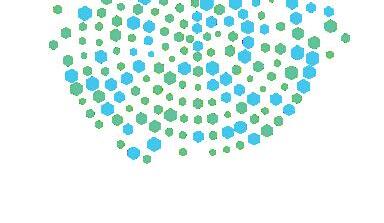

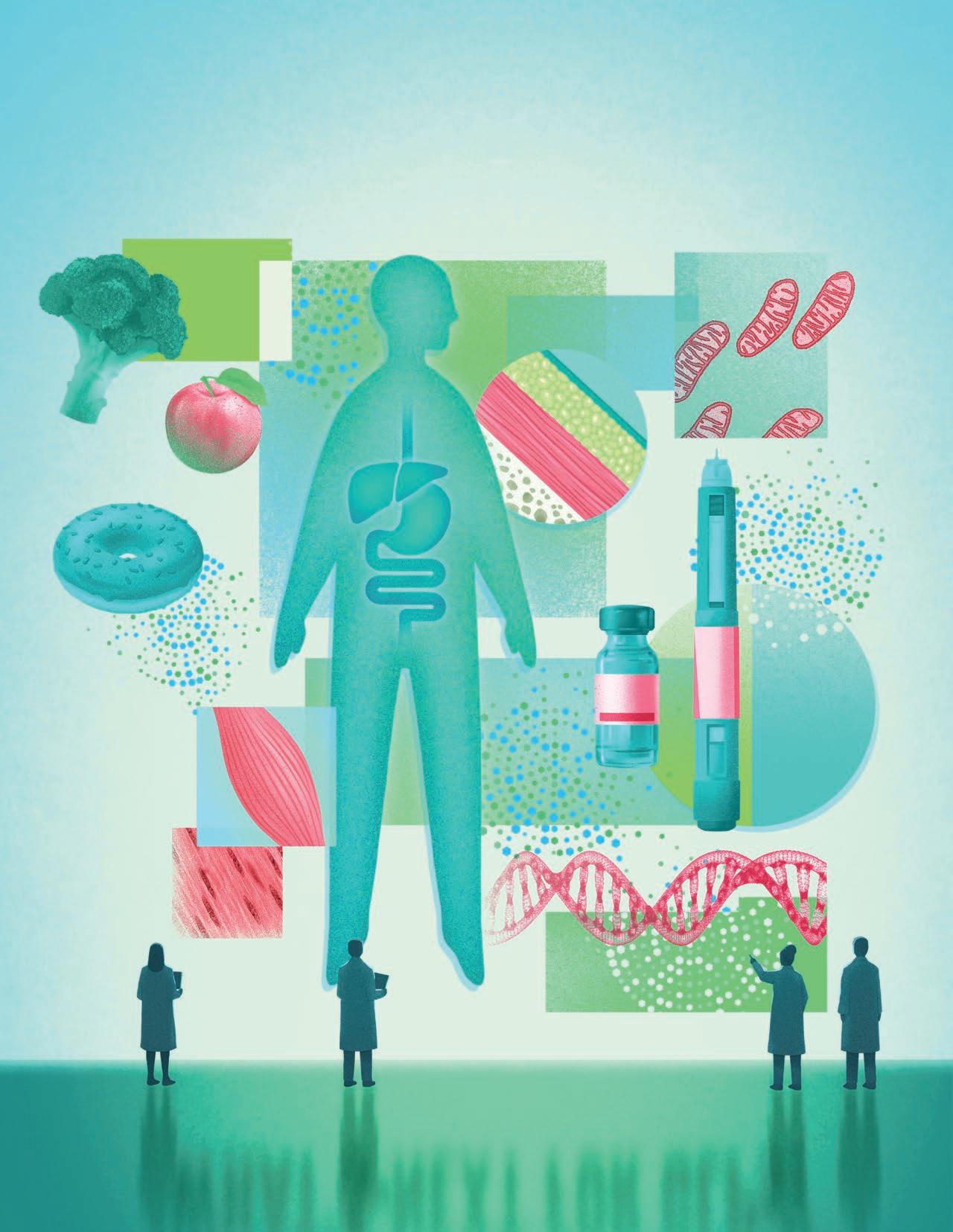
WHAT’S NEXT FOR GLP s? WHAT’S NEXT FOR GLP s?





WHAT’S NEXT FOR GLP s? WHAT’S NEXT FOR GLP s?

As we mark the close of summer, I want to take a moment to reflect on what keeps Salk strong and steadfast amid an ever-changing scientific and funding landscape: our unwavering commitment to fundamental discovery.
At Salk, we live and breathe research. Everyone here, including faculty, student and postdoctoral researchers, research staff, and facilities and administrative personnel, shares a singular mission to advance knowledge that will benefit humanity. That dedication is what gives our work meaning and impact.
This issue of Inside Salk explores one such scientific frontier—the biology behind the GLP-1-based drugs that have transformed the way we treat obesity, diabetes, and other metabolic conditions.. These breakthroughs didn’t arise from thin air. They emerged from years of basic research into how cells use energy and how hormones signal in the body and brain. At Salk, our scientists are now uncovering how to make these medications more precise and more powerful with fewer unwanted side effects, pointing the way to next-generation therapies.
We’re also proud to highlight members of our community who embody Salk’s spirit of innovation and creativity. Professor Nicola Allen’s pioneering work on brain cell communication is providing a new understanding of brain aging and repair, particularly in Alzheimer’s disease.
Our new vice president of External Relations, Michelle Chamberlain, is strengthening ties with those who believe in the promise of basic science and launching the Discovery Society to welcome new supporters to our mission. Postdoctoral researcher Joseph Swift represents the bright future of science, bringing creativity and enthusiasm to the bench every day.
Thanks to steadfast philanthropic support and a robust scientific vision, we’ve entered the new fiscal year on solid ground. Your commitment helps us stay on mission—science that is not for profit, but for the benefit of society. We are deeply grateful for your support.
With gratitude,
Gerald Joyce Salk Institute President

“Your commitment helps us stay on mission—science that is not for profit, but for the benefit of society.”

The Salk Institute received a generous gift from the Prebys Foundation as part of a rapidresponse funding initiative to safeguard San Diego’s biomedical research ecosystem. This funding will support three years of Salk’s cornerstone education pipeline and training programs: Heithoff-Brody High School Summer Scholars, Summer Undergraduate Research Fellowship (SURF), Salk Edge Program, Discover Symposium, and Rising Stars Symposium.



“This support from the Prebys Foundation affirms the importance of nurturing the next generation of scientific leaders,” says Gerald Joyce, Salk Institute president. “We are grateful for this investment, which ensures our ability to provide transformative training experiences to students and early-career scientists, from high school students to postdoctoral trainees.”
The funded programs span the entire STEM education pipeline:
Heithoff-Brody High School Summer Scholars Program : An eight-week, paid summer internship that introduces high school students to laboratory research, providing early mentorship and exposure to real-world science.
Summer Undergraduate Research Fellowship (SURF): A fully paid, 10-week internship offering college undergraduates immersive biomedical research experience, mentorship, and professional development.
Salk Edge Program: A two-week intensive training for graduate students on emerging technologies, complemented by pilot grants that allow students to implement what they’ve learned back in their home labs.
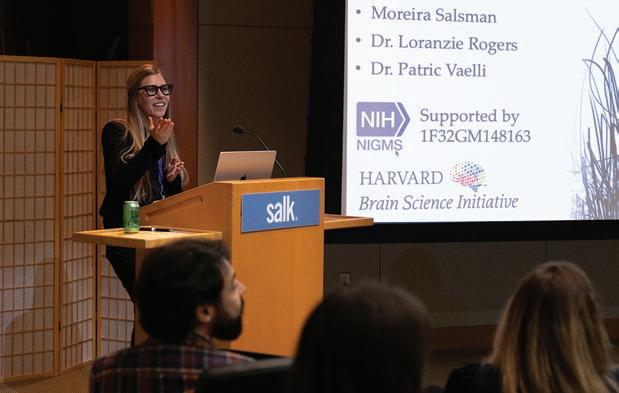


Discover Symposium: A unique platform for graduate students and postdoctoral researchers to present their work, network with potential mentors, and explore interdisciplinary collaborations at Salk.
Rising Stars Symposium: A recognition and recruitment initiative for outstanding postdoctoral scholars, designed to spotlight talent and foster faculty development pathways.
Salk’s education pipeline programs are rooted in the Institute’s mission to drive high-impact science, which requires motivated and well-trained researchers at all levels. These programs have consistently opened doors for students from all backgrounds, offering them unparalleled access to mentorship, resources, and worldclass science.
For more information about Salk’s education pipeline and training programs, including application information, please visit www.salk.edu/training.
The Salk Institute recently announced a landmark partnership with luxury skincare brand La Mer. Through the new La Mer Fellowship in Healthy Aging, the company will fund a three-year postdoctoral position to study human aging at the molecular level.
The inaugural fellowship has been awarded to Ankita Chadda, a postdoctoral researcher in the lab of Assistant Professor Agnieszka Kendrick. Kendrick’s team studies cellular transport—the system of microscopic highways and specialized protein vehicles that move nearly everything inside a cell. This system is indispensable to cellular function and survival. With La Mer’s support, Chadda will use cutting-edge technologies to explore how aging disrupts cellular transport in neurons. This work may reveal new strategies to prevent or reverse transport-related neurodegenerative diseases such as Alzheimer’s.

“At the Salk Institute, we are driven by the pursuit of fundamental discoveries that improve human health,” says Salk President Gerald Joyce. “We are deeply grateful to La Mer for supporting this mission by funding research into aging at a molecular level and empowering the next generation of scientists. Through this unique partnership, we can apply our scientific expertise to explore new frontiers in healthy aging.”
Postdoctoral trainees like Chadda are essential to biomedical science. These trainees have recently earned a PhD, MD, or both. With a faculty mentor,




“As a brand founded by a true visionary, we are privileged to honor our legacy by partnering with an innovative, world-class institute, with some of the most globally renowned scientists.”
SANDRA MAIN, GLOBAL BRAND PRESIDENT OF LA MER
they assist in or lead their own research projects as they take steps toward establishing their careers as independent investigators. Postdoctoral researchers and their work are typically funded by federal or private grants or fellowships, making the new La Merfunded fellowship a unique approach to empowering the next generation of scientific leaders.
“La Mer has always believed in the power of bioenergetics to enhance skin’s natural renewal,” says Sandra Main, global brand president of La Mer. “Our partnership with the Salk Institute reflects our deep commitment to advancing the science of cellular energy, ensuring that our innovations continue to push the boundaries of aging science. As a brand founded by a true visionary, we are privileged to honor our legacy by partnering with an innovative, world-class institute, with some of the most globally renowned scientists.”
Together, Salk and La Mer will explore the intersection of molecular biology and energy metabolism to better understand how the aging process can be slowed—or even reversed. The insights from Chadda’s research may inform future innovations in both medicine and skincare.
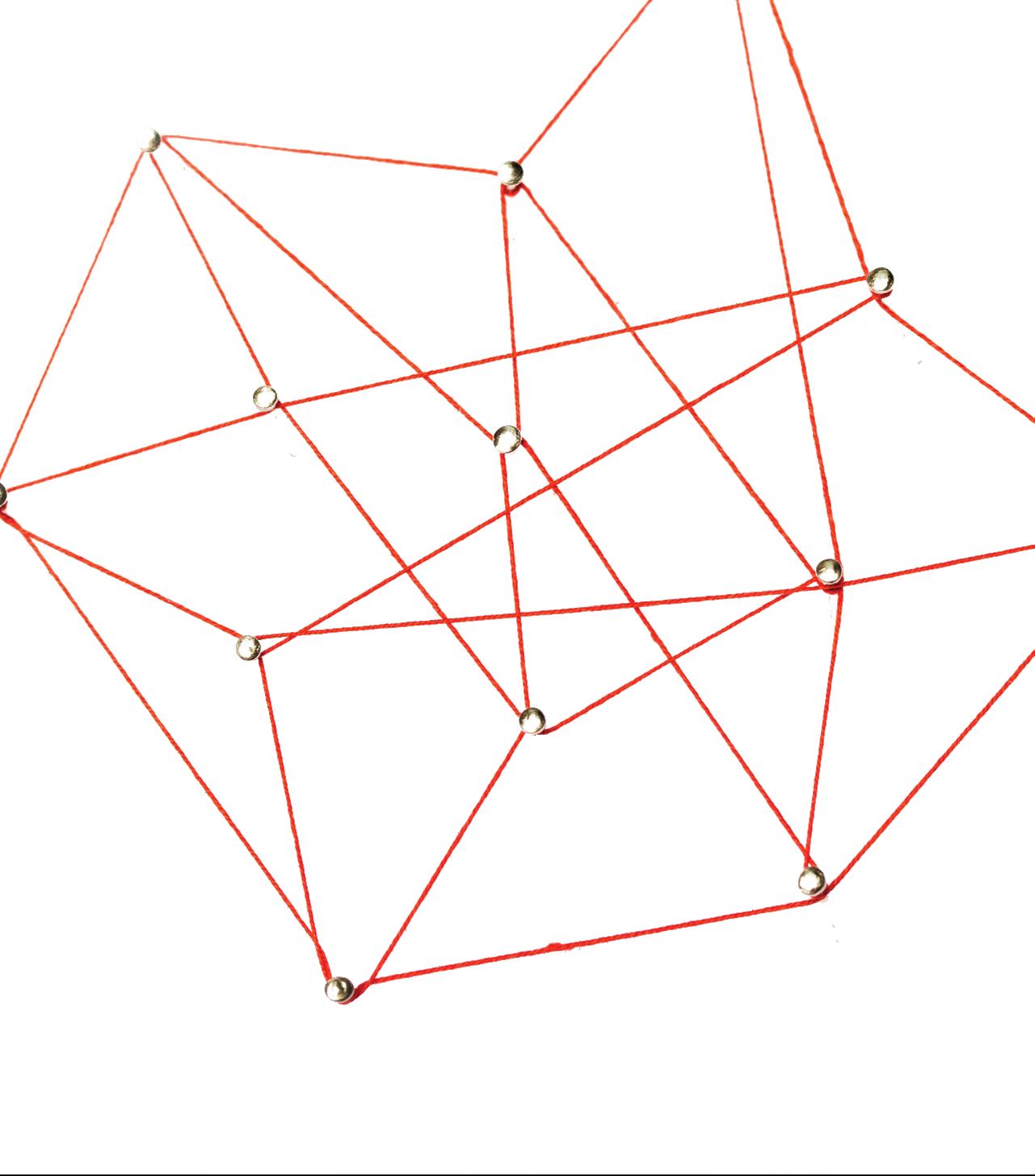
Assistant Professors Lena Mueller and Aga Kendrick joined the Salk Institute in January 2024 and November 2023. Less than two years later, their new labs are already celebrating their first published studies.
Mueller and Kendrick have built their research around connections. For Mueller, those connections are underground, as she explores the mutually beneficial interactions between fungi and plants. For Kendrick, those connections are intracellular, as she investigates how materials and messages are sent from one region of a cell to another, bridging the space between them.
Mueller is figuring out which genes help plants initiate and maintain symbiotic relationships with arbuscular mycorrhizal fungi. In her recent study, published in Proceedings of the National Academy of Sciences, she uncovered a new piece of this puzzle that could be used to strengthen fungi-plant connections. Her findings contribute to a global effort to engineer crops that are better hosts for arbuscular mycorrhizal fungi, with the goal of reducing reliance on chemical fertilizers and increasing agricultural sustainability.
Kendrick’s research is focused on motor proteins, the vehicles that transport items across the cell. Her lab uses advanced imaging tools to investigate their assembly, activity, and communication. One of these tools, called cryogenic electron microscopy, was showcased in her recent study published in Nature
Structural and Molecular Biology. Her findings pave the way for future discoveries on these crucial proteins and how their regulation can prevent or contribute to disease.
These studies are just the beginning for Mueller and Kendrick (pictured to the right). Both scientists are at the forefront of their disciplines, and their innovative approaches will continue to shape the future of science at Salk and beyond.




Our cells rely on microscopic highways and specialized protein vehicles to move everything inside them—from positioning organelles to disposing of cellular garbage. These vehicles, called motor proteins, are indispensable to cellular function and survival, and their dysfunction can lead to severe neurodevelopmental and neurodegenerative disorders. For example, dysfunction of the motor protein dynein or its partner protein Lis1 can lead to a rare fatal birth defect called lissencephaly, or “smooth brain.” Therapeutics that target and restore dynein or Lis1 function could change those dismal outcomes, and developing those therapeutics depends on thoroughly understanding how dynein and Lis1 interact.
NATURE STRUCTURAL & MOLECULAR BIOLOGY
05/2025

Assistant Professor Aga Kendrick, Salk colleagues, and UC San Diego collaborators captured high-resolution movies of Lis1 activating dynein. The movies allowed the team to catalogue 16 shapes that the two proteins take as they interact, some of which have never been seen before. These insights will be foundational for designing future therapeutics that can target these structures and restore dynein and Lis1 function.


PROCEEDINGS OF THE NATIONAL ACADEMY OF SCIENCES
04/2025
Industrial farming practices often deplete the soil of important nutrients and minerals, leaving farmers to rely on artificial fertilizers to support plant growth. In fact, fertilizer use has more than quadrupled since the 1960s, but this comes with serious consequences. Fertilizer production consumes massive amounts of energy, and its use pollutes the water, air, and land.
Assistant Professor Lena Mueller, graduate student Sagar Bashyal, and colleagues are proposing a new solution to help kick this unsustainable fertilizer habit. In their new study, the researchers identified a key molecule produced by plant roots, a small peptide called CLE16, that encourages plants and beneficial soil fungi to interact with each other. They say boosting this symbiotic relationship, in which the fungi provide mineral nutrients to the plants through CLE16 supplementation, could be a more natural and sustainable way to encourage crop growth without the use of harmful artificial fertilizers.


PROCEEDINGS OF THE NATIONAL ACADEMY OF SCIENCES
05/2025
Across the body, tiny bean-shaped structures called mitochondria turn the food we eat into usable energy. This cellular-level metabolism is especially important in muscle cells, which require a lot of fuel to power our movement. However, 1 in 5,000 people are born with dysfunctional mitochondria, and many others develop metabolic dysfunction later in life in association with aging or diseases like cancer, multiple sclerosis (MS), heart disease, and dementia.
Mitochondrial dysfunction is difficult to treat, but recent findings from Professor Ronald Evans, staff scientist Weiwei Fan, and colleagues show that a group of proteins called estrogen-related receptors could be a new and effective therapeutic target. The scientists discovered that estrogen-related receptors play an important role in muscle cell metabolism, especially during exercise. When our muscles need more energy, estrogen-related receptors can increase the number of mitochondria and enhance their energetic output within muscle cells. The findings indicate that developing a drug to boost estrogen-related receptors could be a powerful way to restore energy supplies in people with metabolic disorders, such as muscular dystrophy.
“Our lab discovered estrogen-related receptors in 1988 and was one of the first to recognize their role in energy metabolism. Now we’ve learned that estrogen-related receptors are indispensable drivers of mitochondrial growth and activity in our muscles.”
PROFESSOR RONALD EVANS



Because mitochondria are so important for survival, cells have developed a specialized information pipeline, called mitochondrial retrograde signaling pathways, to get periodic updates on their mitochondria’s health. One of these pathways evaluates mitochondrial fitness by sensing how much mitochondrial DNA (mtDNA) is present in the cell— low levels of mtDNA can signal mitochondrial stress and encourage inflammation. Until now, the pathway controlling mtDNA sensing in mammalian cells was poorly understood.
Research from Professor Gerald Shadel, postdoctoral researcher Alva Sainz, and colleagues identified the protein FAM43A as an early responder to mtDNA depletion in mammalian cells. When FAM43A levels are suddenly reduced, a mitochondrial rescue mission ensues, increasing mitochondrial mass and rescuing mtDNA levels. Their findings enrich scientific understanding of mitochondrial stress, which could inform future treatments for many neurological, metabolic, and agingrelated disorders.





The connection between two neurons, called a synapse, allows information to flow from one brain cell to the next. Healthy synapses enable us to think, learn, and make memories. However, the exact process for creating and stabilizing new synapses are poorly understood.
Professor Nicola Allen, graduate student Alexandra Bosworth, and colleagues have now shown that nonneuronal brain cells called astrocytes are surprisingly critical for maintaining healthy synapses. Using a mouse model, the researchers found that astrocytes produce a protein called glypican 5 that is necessary for the proper maturation and refinement of synapses. Without glypican 5, synapses lose structural maturity and cause the pre- and post-synaptic portions of neighboring neurons to shrink. This information could now influence the development of new therapeutics for brain disorders that involve synaptic dysfunction, including Alzheimer’s disease and frontotemporal dementia.


Cannabis has been a globally important crop for millennia. While best known today as marijuana for its psychoactive cannabinoid THC (tetrahydrocannabinol), cannabis has historically been a cornerstone of human civilization, providing seed oil, textiles, and food for more than 10,000 years. Today, cannabis remains an understudied and underutilized resource, but United States legislation passed in 2014 and 2018 has re-energized cannabis crop development for medicinal, grain, and fiber applications.
Research Professor Todd Michael and postdoctoral researchers Ryan Lynch and Lillian Padgitt-Cobb, alongside Salk colleagues and collaborators from Oregon CBD, Oregon State University, and the HudsonAlpha Institute of Biotechnology, have created the most comprehensive, high-quality, and detailed genetic atlas of cannabis to date. The team analyzed 193 different cannabis genomes (entire sets of genetic information), revealing an unprecedented diversity, complexity, and untapped opportunity within this foundational agricultural species. Their findings set the stage for transformative advances in cannabis-based agriculture, medicine, and industry.

“Cannabis is one of the most extraordinary plants on Earth. Despite its global importance as a source of medicine, food, seed oil, and fiber for at least the last 10,000 years, it remains one of the least developed major crops of modern times, largely due to a century of legal restrictions.”
RESEARCH PROFESSOR TODD MICHAEL



Every day, our bodies are tasked with finding food, turning that food into usable energy, and then spending that energy wisely on things like breathing, moving, thinking, and healing. This series of processes, collectively known as metabolism, is coordinated by a complex network of genes. Switching on and off like an array of microscopic levers, these genes tell our cells when to store energy, when to burn it off, and whether to tap into fat, muscle, or sugars for fuel.
This exquisitely balanced system worked well when humans spent their lives farming fields, hunting for food, and traveling on foot, but in the modern world, it seems to be breaking down, says Professor Ronald Evans, holder of the March of Dimes Chair in Molecular and Developmental Biology at Salk.
“We’re seeing a global increase in weight and excess body fat, beginning at younger and younger ages,” he says. “We’re not sure exactly why it’s been happening, but it’s definitely not going backwards.”


Enter glucagon-like peptide-1, or GLP-1, a hormone that is produced naturally in the body and plays an important role in appetite suppression. But while GLP-1 agonists like Ozempic® and Wegovy® have exploded in popularity in recent years, Salk researchers, along with other scientists, have been studying GLPs for decades.
It’s long been known that GLP-1 is involved in regulating metabolism to control functions like calorie intake and sugar levels. Now, Evans and other Salk faculty are using their research on GLPs and the basic science of metabolism to help advance the next generation of GLP-based weight-loss therapies.
“What we’re starting to see is that every nutrient we consume takes its own path through the body, and any drug we take or any disease we have tends to alter that,” says Professor Christian Metallo, holder of the Daniel and Martina Lewis Chair at Salk. “The more we know about this system at the molecular level, the better we can understand and control it.”








For many patients struggling with obesity, GLP-1 medications have been transformative. By treating their metabolism, these drugs empower sustainable long-term weight loss and reduce the risk of heart disease, diabetes, cancer, and a host of other dire long-term outcomes.
But the drugs are far from perfect.
“It is a blockbuster drug for diabetes and obesity, but we are well aware of its side effects,” Evans says.

Along with issues like nausea and vomiting—a common complaint that causes many patients to stop the medication and regain the weight—muscle loss is another serious concern.
In fact, about 40 percent of the weight people typically lose on GLP-1 drugs comes from lean mass, primarily muscle tissue. This can lead to weakness and increased risk of frailty, especially in older adults. And while doctors typically recommend exercise to people taking these drugs, muscle loss can actually make some exercises more challenging or less effective.
As we’re working on the next generation of these drugs, the big question is how we can stave off their potential side effects.”
PROFESSOR CHRISTIAN METALLO
Nausea, vomiting, and muscle loss—serious complications are pushing some patients off the meds and back to weight gain.

Other, less well-understood side effects of GLP-1 drugs include reports of retinal changes and vision problems, as well as mental and cognitive changes. Metallo says he expects more side effects to emerge as more people take GLP-1 agonists and new versions of the drugs enter the market.
“As we’re working on the next generation of these drugs, the big question is how we can stave off their potential side effects,” he says.

“

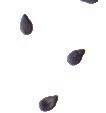




In contrast, FXR drugs stimulate natural GLP-1 production in the body. The GLP-1 produced this way would be broken down faster, just like it would after a meal. This would deliver all the appetite-suppressing benefits without keeping the hormone in your system for so long that it starts to trigger side effects. What’s more, patients could take FXR drugs as a daily pill instead of the injections required for synthetic GLPs.
Activating the FXR pathway also fights obesity in two different ways. In addition to suppressing appetite through GLP-1 production, it also releases a second hormone, called fibroblast growth factor-19, that directs the body to burn energy.
”
GLP-1 is normally released in response to food; the hormone sends a signal that the body has had enough and tells the brain to stop eating. The current generation of weight loss drugs works by injecting a synthetic version of GLP-1 into the body to suppress appetite. Evans’ lab is working on a receptor called FXR that stimulates the body to produce GLP-1 naturally.
“We call these FXR compounds our ‘Meal in a Pill,’” Evans says, “because they activate genes that would normally be activated during a meal, but there is no meal—we’re activating it with a compound.”
This approach potentially offers several advantages over the current class of synthetic GLP-1 drugs.
“It’s not simply mimicking GLP-1,” says Weiwei Fan, a staff scientist in Evans’ lab. “It’s triggering a more natural response.”
Natural GLP-1 molecules break down quickly, but synthetic versions have a much longer half-life. This prolonged exposure enhances appetite suppression, but it may also cause many of the unwanted side effects.
“It’s cutting down calorie intake, and at the same time it’s boosting the burning of calories in the body,” Fan explains. “It’s targeting the obesity problem from both sides of the energy balance.”
Researchers hope this could help people lose weight with less muscle loss, Fan says. He notes that, in mouse studies of FXR, most weight loss came from fat, and lean muscle mass was not significantly affected.
“We think this is partly because FXR works by both reducing food intake and increasing energy expenditure,” Fan explained. “That means you won’t need as much reduction in food intake to reach the same weight loss goal, because a lot of this boosted energy expenditure is upon fat.”
In clinical trials, FXR is already showing promise as a target for fatty liver disease, another serious metabolic disorder, and Salk researchers are in discussions with pharmaceutical companies about developing an FXRbased obesity drug.

Natural GLP-1

Salk researchers are also tackling the issue of muscle loss. Metallo notes that the way GLP-1 drugs suppress appetite leads the body to enter a kind of starvation state.
“Your body responds not just by burning fat; it actually starts to break down muscle and other proteins,” he says. “What needs to be better understood is, when you go through that prolonged starvation state, what else is being burned beyond the fat?”

It’s also easier for the body to make more fat than it is to make muscle, which is one reason why people who go through yo-yo diets can find it progressively harder and harder to keep the weight off, he notes.
Metallo’s lab studies how amino acids, the building blocks of proteins, are also used to make important fatty compounds called sphingolipids. He has zeroed in on the amino acids serine and glycine, which play an important role in supporting muscle regeneration, retinal health, and the peripheral nervous system.
The team’s research found that serine and glycine are broken down by an enzyme produced in the liver, and they’re now working on approaches to target that enzyme. The goal is to develop a drug that could be given alongside GLPs to help prevent muscle loss as people lose weight.
“Ideally, you want to trigger the body to maintain its energy levels by burning fat, instead of amino acids—especially these amino acids, which we know are critical in both muscle tissue and the nervous system,” Metallo says.


When the body is hungry, the brain sends growth hormone (pink) to protect the muscle tissue. This allows BCL6 (purple) to bind DNA and regulate genes for muscle preservation. Researchers are now exploring BCL6’s role in maintaining muscle during weight loss.
Evans’ team is also interested in another receptor called PPAR-delta, which helps stimulate genes involved in fat metabolism. Activating this receptor causes the body to expend energy (burn calories) not through movement but by generating heat.
We’re very excited about these new targets, and we think they are opening up an entirely new opportunity in weight management. It’s happening quickly, and I think it’s going to have a big impact.”
PROFESSOR RONALD EVANS

The researchers are also exploring a hormone receptor partner called BCL6, which plays a role in regulating muscle development and function.
“Our newest discovery shows that BCL6 is very important for maintaining muscle mass,” Evans explains.

Researchers are now investigating whether activating the BCL6 pathway could help prevent muscle loss in patients taking GLP-1 drugs.
“We’re very excited about these new targets, and we think they are opening up an entirely new opportunity in weight management,” he says. “It’s happening quickly, and I think it’s going to have a big impact.”
Salk scientists are also exploring how the fat in our adipose tissue is metabolized. They have found that certain fatty acids in the bloodstream correlate with insulin sensitivity, while others are linked to insulin resistance. An open question is whether dramatic changes to a person’s fat mass could affect that balance, Metallo says.
These are pathways that literally were not known to exist until we discovered them. This is how basic research really unlocks the future.”
PROFESSOR RONALD EVANS
For Salk researchers, the emergence of drugs like Ozempic and Wegovy doesn’t represent the culmination of GLP research— it marks the beginning.
“Everything we’re learning from the clinical use of GLP-1 drugs just motivates us even more to understand how every tissue and cell in our body handles nutrients, and how that changes in the context of disease,” Metallo says.
They also underscore the importance of basic science research to lay the foundation for new treatments that improve health and save lives. Evans pointed to his team’s work on FXR, PPARdelta, and BCL6 as an example of where weight loss medicine could go next.
“These are pathways that literally were not known to exist until we discovered them,” he says. “This is how basic research really unlocks the future. Because we have advanced tools, we can find something new, quickly deconstruct what it is acting on, and then create modifications of that pathway to promote healthier function.”
Obesity research at Salk could also help advance treatments for other diseases.
The PPAR-delta pathway is an attractive target for obesity treatment because of its role in regulating energy expenditure, but there’s growing evidence that it is also important to other cell types, including microglia, a type of immune cell found in the brain.
“We think activating PPAR-delta in those brain immune cells may have major benefits for neurodegenerative diseases, including Alzheimer’s,” Fan says.
Evans’ team also recently completed a clinical trial in patients with cardiovascular disease, extending their track record of successful bench-to-bedside projects.
While stimulating certain metabolic pathways is being tested to promote muscle growth, blocking those same pathways could also slow cancer, Metallo says.
“I’ve learned a lot by jumping from disease to disease,” he says, “because in the end, the metabolism is the same—it’s just wired a little bit differently.”




In April, Salk employees joined our Engagement & Wellbeing team for a week of community-building.
Salk employees and trainees were encouraged to step outside of their administrative offices or labs to engage with each other through a coffee hour, time capsule burial, creative salon, paper airplane competition, and more.
Strong personal connections foster trust, open communication, and creative collaboration, which are key to tackling complex scientific questions. In a close-knit environment like ours, these relationships fuel the bold, interdisciplinary work that defines Salk’s mission and accelerates our collective impact.


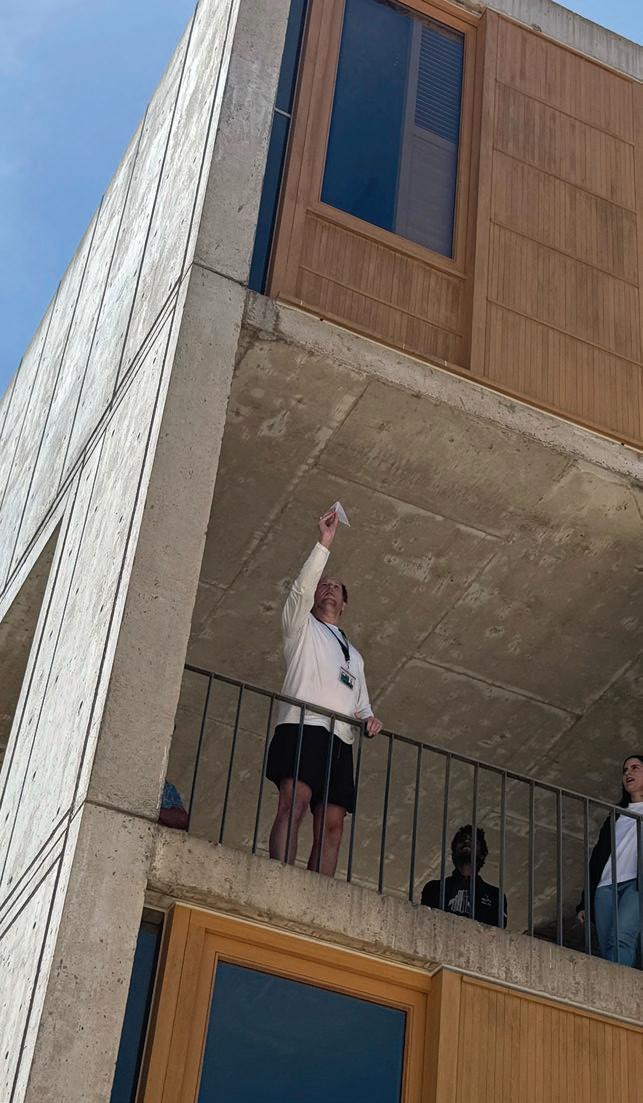
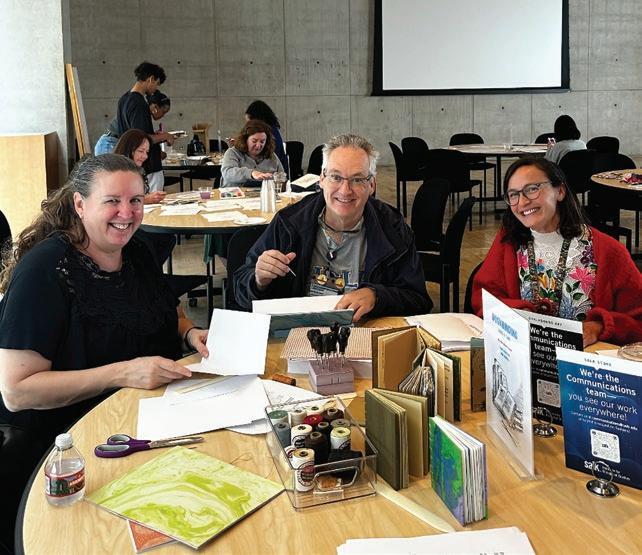
It turns out Salk’s plant biologists aren’t the only Salk employees with a green thumb. In celebration of Earth Day, Salk employees enjoyed swapping plants, sharing gardening tips, and planting seeds to take home, cultivating growth in more ways than one.



The “A Glimpse of Us” series welcomes a leader on Salk’s campus to present for one hour about their background, career journey, passions, and more. Pek Sze Baird, supervisor of Events Operations, was already a familiar face around campus, but sharing her journey through dance and martial arts and her training in event planning gave the community a new appreciation for her. She emphasized the dedication of the staff members who work tirelessly behind the scenes to manage everything from scientific symposia to donor appreciation events.
To support a healthier, more connected workplace, the Engagement & Wellbeing team offers Wellness Wednesdays—free yoga led by Salk’s own Megan Hollyfield of the Education Outreach team. By taking a break from our labs and offices during lunch, we’re able to strengthen not only our bodies but our sense of camaraderie, helping make Salk a more supportive and inspiring place to work.



This year’s High School Science Day at the Salk Institute marked a milestone in community engagement and student inspiration. With the highest participation in the event’s history, the day welcomed 205 students to experience firsthand the wonder of science in action. The event, powered by the enthusiasm and generosity of 105 Salk volunteers, offered a rare glimpse into the inner workings of a world-class research institute and left a lasting impression on everyone who attended.
“When I teach, my students just assume it’s limited to the classroom. Research is spoken about very abstractly, but Salk makes it a reality.”
ROBERT
BIOLOGY TEACHER
More than just a field trip, Science Day proved to be a transformative experience. Ninety-eight percent of students reported feeling either the same or more interested in pursuing a career in science. The day was filled with moments of discovery, connection, and empowerment, as students engaged directly with Salk scientists, toured labs, and explored career paths that had previously seemed out of reach or unimaginable.
One of the event’s most enduring supporters is Robert Manroe, a biology teacher at Castle Park High School in Chula Vista. For 20 years, Manroe has brought students to the Salk Institute’s Science Day. With 35 years in the classroom, he currently teaches advanced biology and sees the event as an essential supplement to his curriculum.
“When I teach, my students just assume it’s limited to the classroom,” he says. “Research is spoken about very abstractly, but Salk makes it a reality.”
That tangible connection to science is precisely what resonated with students. Many described the most powerful aspect of the day as the opportunity to interact directly with scientists who were not only deeply knowledgeable but also approachable, relatable, and passionate.
“The most impactful moment was seeing how down-to-earth the scientists and researchers are,” one student shared. “It makes the field seem a lot more achievable.”
Others noted how the event reframed their understanding of career paths in science. “Talking to the scientists and hearing the panelists talk about all the paths they took to get where they are made me realize higher education doesn’t have to be linear,” said another student. “I’m not already locked into a specific future just because I chose a certain major.”
For Brad Hirakawa, the 1991 High School Science Day offered a moment of personal transformation. In a video from the Salk archives, bright-eyed teenage Hirakawa reflects on the day, “It enhanced my way of thinking. Now I’m more interested in science.” He continues, “It’s motivation. You see what you can do, what you’re capable of. I look up to them. I hope someday I can be that.”
Now the director of Drug Safety Strategy and Operations at a local pharmaceutical company, Hirakawa credits the event with launching his scientific journey.
“As a high school student from Chula Vista High, I had the rare and unforgettable opportunity to attend a student outreach event at the Salk Institute with my AP Biology teacher and now long-time friend, Steve Rodecker,” he recalls. “That experience profoundly shaped the course of my life. Meeting scientific giants like Francis Crick and Jonas Salk, who took the time to speak with us young students, sparked in me a deep and lasting passion for science. That day opened the door to my life in science, and I remain deeply grateful.”
High School Science Day is more than a one-day event; it’s a catalyst for curiosity and a launchpad for future scientists.



A mid-morning hush falls over the Conrad T. Prebys Auditorium as the first slide of a research talk flashes on the screen. Teachers lean in and scribble notes, and occasionally snap photos of the data being presented. They’re not here to grade papers or collect attendance this time.
Robert Manroe, who brings his students to High School Science Day, leads by example and opts to spend a day as a student at Salk’s Ellen Potter Teacher Symposium.
Named in honor of neurobiologist Ellen Potter, a longtime Salk scientist and champion of public education, the symposium reflects the Institute’s deep belief that science education shouldn’t stop at the lab bench or stay behind closed doors. Potter herself, who mentored generations of researchers, is known for her ability to translate complex ideas with warmth and clarity, especially to curious minds just entering the world of science.
Throughout the day, educators sit side-by-side with Salk scientists. They discuss neuroscience, genetics, plant biology, and regenerative medicine. Over lunch, lesson plans are swapped and email addresses exchanged.

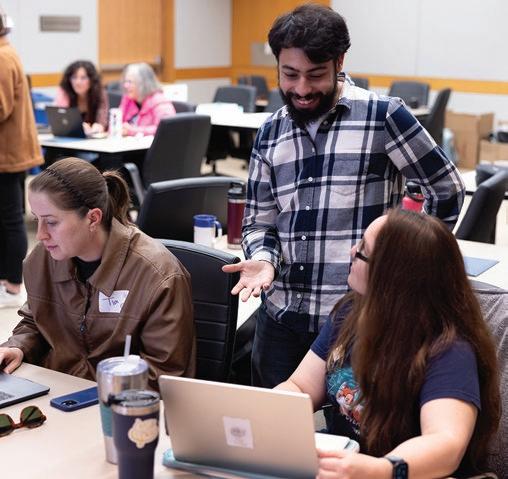
Hands-on activities, like CRISPR gene editing demos or pipetting practice, bring the excitement of the lab into the palm of a teacher’s hand.
“One of the drawbacks to teaching science is that once you’re settled, it’s easy for our content knowledge to become outdated,” says Manroe, with 35 years in the classroom under his belt. “It’s powerful to be there as an educator, to keep me sharp.” For Manroe, seeing cuttingedge research like CRISPR in action not only informs his teaching but makes it more tangible and exciting for students.
“It feeds us,” Manroe reflects on the day. “It helps us rediscover why we’re excited by the science and reminds us why we got into this field in the first place.” It serves as a reminder of their “why,” in a field that can become routine or burdened by administrative demands. This creates a ripple effect because an energized teacher fosters energized learners.
“It feeds us. It helps us rediscover why we’re excited by the science and reminds us why we got into this field in the first place.”
MANROE, CASTLE PARK BIOLOGY TEACHER



In the brain’s large cast of characters, neurons tend to steal the show. These specialized cells have dominated neuroscience research and funding for decades—and for good reason. Their electrical signals form the basis of all our thoughts, feelings, movements, and memories.
But behind the scenes, a group of star-shaped cells called astrocytes has been quietly influencing nearly every aspect of brain health and disease. Salk Professor Nicola Allen has been instrumental in bringing these underappreciated cells into the spotlight.
By daring to focus on what most others had overlooked, Allen helped usher in a paradigm shift. Many researchers now believe astrocytes and other non-neuronal brain cells could be the missing piece to understanding and treating many neurological diseases.
But much like the cells she studies, Allen isn’t one to seek the limelight. The British neuroscientist moves through her successes with great humility, quick to credit her collaborators and shift attention to the work that’s left to do. She speaks about her research with a measured precision. That also means when she believes in something, you know she has the data to back it up.
This combination of bold inquiry and grounded rigor is one of the many reasons Allen was recently promoted to full professor at the Salk Institute and bestowed the Roger Guillemin Chair. In the last year, she’s taken a leading role in the Institute’s new Neuroimmunology Initiative and its Year of Alzheimer’s Disease Research. She also received the 2024 National Institutes of Health Director’s Pioneer Award, which recognizes influential researchers pursuing high-risk, high-reward science.

Inside Salk sat down with Allen to learn how astrocytes are taking center stage in the future of brain health.
Where did your interest in science begin?
ALLEN: Growing up in the UK, we used to do these experiments in our science classes, like tossing a grid out on the grass and counting all the different kinds of plants we could find. They were simple, but they made me curious about the world around me. My biology teachers were also really excellent and very encouraging while I applied for university.
For a while, I thought I might become a veterinarian because I loved animals, so I started taking courses in anatomical sciences. But I quickly realized I wasn’t as interested in applying treatments as I was in figuring out the mechanisms behind them. I wanted to get to the root of the problem and make a difference by developing something new, rather than implementing what we already had. So that drew me toward a career in research.
What led you to neuroscience, and eventually astrocytes?
ALLEN: As an undergrad, the two things I found most interesting were neuroscience and immunology, probably because they’re the two major systems we knew the least about. I actually wrote my undergraduate thesis on how the immune system might interact with the brain, but this was long before we thought of neuroimmunology as its own discipline.
I did my PhD in London, studying how neurons are affected during stroke. I was using classic neurophysiology techniques to measure the neurons’ electrical activity. It’s amazing, really, to record what the brain is doing in real time. But there was also this recent explosion of new tools in molecular biology, so my advisor sent me to New York for a three-week course in molecular neuroscience at Cold Spring Harbor Laboratory.
That’s when I saw Ben Barres give a completely mind-blowing talk that changed everything for me.
Ben went up in front of this room of neuroscientists and showed us that when you isolate neurons from the rest of the brain and grow them in a dish, they don’t form any connections with each other. They don’t communicate. But if you add these other cells— astrocytes—then there are now tons of synaptic connections and tons of electrical activity moving through the neuronal circuit.
It was this amazing finding that really changed how I thought about brain development and what all these different cell types do. I immediately thought, I need to do my postdoc with this person. And that’s when I moved to Stanford University.
What was the perception of astrocytes at the time?
ALLEN: Astrocytes are a type of non-neuronal brain cell called glia. Glia were first thought to exist as a sort of structural scaffolding for the neurons to grow on. Then, we learned that astrocytes support the neurons in some more specialized ways, like bringing nutrients from the blood vessels to help fuel the neuron’s activity. So, they were important, but not considered to play an active role in how our brain communicates or processes information.
Once we had better tools to study these cells, all of that changed. But it took a long time for the rest of the field to appreciate our findings.
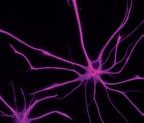
We’re just beginning to fully appreciate the role of glia and astrocytes in the brain, and we’re already seeing so much potential for new therapeutic strategies. I think their story shows that exploring the unknown isn’t just bold or brave— it’s essential.”
PROFESSOR NICOLA ALLEN
How has your work changed our understanding of the brain?
ALLEN: Our research has found that astrocytes play a very active role in brain development and plasticity. They don’t just support the neurons; they instruct them. The astrocytes are the ones releasing the signals that tell neurons to form synaptic connections with each other. Later, they release different signals to tell the neurons which synapses to keep and which to get rid of. They help build the brain’s circuitry, and then reshape it over time.
We’ve also learned that neurons can respond to astrocytes and give them feedback. It’s this amazing orchestration between cell types that keeps the brain circuits running smoothly. But if this communication breaks down in any way or the cells start sending the wrong signals, that can have a serious impact on the brain’s wiring. It’s why we’re now finding that astrocytes contribute to many neurodevelopmental and neurodegenerative diseases. But that also means they could be the key to treating them.
How do astrocytes contribute to Alzheimer’s disease?
ALLEN: Most Alzheimer’s research has focused on the amyloid plaques that can form between neurons. What’s interesting is that these plaques are surrounded by astrocytes and other glia. But we’re just starting to investigate what these cells are doing there.
We also have data showing that Alzheimer’s patients have far more genetic changes in their glial cells than in their neurons. That’s made a lot of people start paying attention to these other cell types.
What’s especially interesting to me is how astrocytes could be contributing to even earlier stages of the disease. My lab has now identified the specific proteins that astrocytes secrete to promote synapse formation and stabilization. In Alzheimer’s models, astrocytes seem to produce less of these signals, sometimes even before any symptoms arise. That’s key, because synapse loss is a major driver of cognitive decline. We’re now testing whether restoring these signals could be enough to rescue some of the synapse loss or delay it long enough to preserve cognitive function.
How does this work relate to Salk’s new Neuroimmunology Initiative?
ALLEN: The Neuroimmunology Initiative brings together researchers from neuroscience, immunology, aging, and cancer to understand how the immune and nervous systems impact each other in both health and disease.
For example, my lab recently found that as we age, astrocytes start activating immune genes. These are brain cells expressing immune signals that are typically used to fight off infections or cancer. That raised a lot of questions: What’s triggering this? Is it helpful or harmful? How does it affect neuronal function, memory, and behavior?
To answer these kinds of questions, I’m collaborating with Professors Susan Kaech, Diana Hargreaves, Axel Nimmerjahn, and other experts here at Salk. Together, we’re unpacking the role of glial-immune interactions in aging, Alzheimer’s, cancer, chronic pain, and more.
I think it’s possible that at the end of this, we could have a drug that dampens down the chronic neuroinflammation that contributes to all of these disorders.

What project are you most excited about right now?
ALLEN: I’m really excited that we’re finally at a place where we can start to use what we’ve learned about astrocytes to modify the state of the brain.
Now that we’ve identified the proteins that astrocytes use to trigger synapse formation, we’re developing tools to deliver them as needed: adding or blocking these signals when you want to create, repair, or remodel the connections between neurons. It’s a totally different way of treating the brain—not by altering neurons directly, but by tuning the environment around them.
I think 20 years ago, people would’ve thought it wasn’t possible, or that you should focus on making drugs that target neurons. But neurons are very precious, so if we can do an intervention that doesn’t mess with the neurons directly, but instead uses these environmental cues to guide their activity toward a healthier state, to me, that’s a better way.
Why is Salk the right place to do this kind of science?
ALLEN: Salk is special because of the people. There’s a culture of curiosity here. People are excited about new ideas, even if they’re outside the mainstream. When I arrived, glial biology was still considered fairly niche, but my colleagues were genuinely enthusiastic and eager to collaborate.
The Institute’s structure also encourages these collaborations. I’m meeting weekly with experts on cancer, aging, immunity, and genomics. That crosstalk accelerates everything.
We’re just beginning to fully appreciate the role of glia and astrocytes in the brain, and we’re already seeing so much potential for new therapeutic strategies. I think their story shows that exploring the unknown isn’t just bold or brave—it’s essential. Science moves forward when we give researchers the freedom to ask big questions, and the tangible support to see them through. The kinds of questions we’re asking—about aging, memory, inflammation, and regeneration—require that kind of ecosystem. And it’s exactly what we have here at Salk.

Salk is special because of the people. There’s a culture of curiosity here. People are excited about new ideas, even if they’re outside the mainstream.”
PROFESSOR NICOLA ALLEN


Daughter, cousin, student, friend, scholar, teacher, attorney, board member, wife, fundraiser, leader— Michelle Chamberlain has grown in and out of these many roles throughout her lifetime. Whether it’s by blood or by coincidence, each part of her life can be traced to a relationship she’s made. A commitment to friends, family, colleagues, and newcomers alike sets her apart and has inspired her search for a career that’s both personally meaningful and globally impactful.
Today, Chamberlain serves as vice president of External Relations at Salk. Alongside other Institute leaders, she oversees all fundraising efforts, communications, community engagement, foundation relations, and stewardship activities.
“I grew up in a small community in Southern California,” says Chamberlain. “I have a very close-knit group of friends that I’ve maintained since elementary school. And as an only child, I was lucky enough to have six female cousins close to my age that helped me develop skills like socializing and compromising that I otherwise couldn’t get.”
Chamberlain was also incredibly close to her grandmother, whom she visited every day after school. These many relationships supported her educational success, which was a priority in her house. “My parents had jobs, they needed to go to work every day,” she explains, “and it was clear that my job was to be a student.”
By 17, Chamberlain was studying political science and economics at the University of Southern California in Los Angeles.
Chamberlain was surrounded by pre-law students, and, though curious, she was unsure about law by the end of her degree. Instead of rushing into law school, she began teaching fifth and sixth grade.
“In classrooms, you learn about motivating others. You learn about a sense of community and how you develop it. You learn how people learn, how people communicate,” recalls Chamberlain.
“The foundational science that we are doing now is going to touch the lives of every single one of us. That is what this world needs.”
But after five years, Chamberlain realized her interest in law school remained. So, she recalibrated, then dove headfirst into law school. Aiming to combine her education experience with law, she accepted a full scholarship at Southwestern Law School to pursue a career in policy. However, plans changed after a summer internship at O’Melveny & Myers LLP, the law firm she joined after passing the California bar exam.
“My family calls me the world’s most unhelpful attorney,” laughs Chamberlain. “I was not a litigator—I was on the structured finance team, and I never set foot in a courtroom. I worked with large global private equity firms, helping them make investments and sell companies.”
But she felt education pulling her back.
“I loved the law. It was challenging and fast-paced. But for me, it felt a little too attenuated from the real challenges of the world,” says Chamberlain. “We had a client at the time, a wonderful man named Robert Day, who happened to graduate from Claremont McKenna College. One thing led to another, and I ended up leaving the law firm to join what is now known as the Robert Day Scholars Program at Claremont McKenna College.”
Over the next 17 years, Chamberlain grew and outgrew multiple roles, eventually landing as the vice president of advancement and student opportunities and dean of the Robert Day Scholars program (it was a very long title that represented years of collecting responsibilities, she says). And all the while, she led the first billion-dollar campaign in liberal arts college history.
After nearly two decades, Chamberlain took stock of her surroundings—the record-breaking campaign had ended, Day had passed away, and the president she’d worked with for more than a decade was set to retire. For Chamberlain, “it seemed like that was the moment to make the move.”

“Cancer has been a huge component, unfortunately, of my family’s history and experience. My grandmother had ovarian cancer. My aunt and my mother have both had breast cancer. I lost a cousin to lung cancer,” says Chamberlain. “When I began thinking of leaving Claremont McKenna, I wanted to go somewhere where I could put down similar roots, where I could invest in the community. I was looking for another 17-year run like I had at Claremont.”
Chamberlain joined the Salk Institute in April 2025, inspired not only by the world-class cancer research and 50-year-old National Cancer Institute-designated Cancer Center, but by Salk’s ethos. “The openness of our research, the nonproprietary nature of our findings— it’s very special and necessary to advance science.”
“The foundational science that we are doing now is going to touch the lives of every single one of us,” says Chamberlain. “And that is what this world needs. I find that the work being done here is truly the work that we need to accelerate.”
With teaching and management skills from the classroom, analytical and communication skills from law, and planning and fundraising skills from higher education, Chamberlain is uniquely positioned to champion Salk science.

When she’s not at work, Chamberlain is busy exploring San Diego and making sense of new people, places, and things. Thankfully, her husband, rescue dog, and parents relocated with her, and most of their extended family is just a short drive away.
Her relationships are the backbone of Chamberlain’s story. Her friends and cousins sharpened her social and emotional skills, her parents motivated her extensive education, Robert Day led her to Claremont McKenna, and her family’s cancer journeys inspired her passion for scientific discovery.
“The most important element of this transition is that I really saw a community that I wanted to be a part of for years, if not decades to come, and that that community is engaged in some of the most remarkable work that the world so desperately needs,” says Chamberlain. “To be able to amplify that message and bring new and old friends into this incredible community is such an honor.”
Together, we can build a healthier, brighter tomorrow—one discovery at a time. By including the Salk Institute in your estate plans, you empower long-term, risk-taking research and innovation that may not be eligible for current funding and will drive breakthroughs to improve human health and wellbeing for decades to come. Many gifts have financial and tax benefits, and all allow for naming opportunities to honor your family or a loved one.
We invite you to be the newest member of Partners in Research, Salk’s legacy society, and enjoy exclusive invitations to events, early access to major discoveries, VIP tours of Salk’s iconic architecture and labs, and so much more!



To learn more about including Salk in your estate plans, please visit www.salk.edu/plannedgiving or contact Cheryl Dean (858) 543-1228 or cdean@salk.edu
Plant biologist and startup co-founder Joseph Swift had an idyllic upbringing in the suburbs of Brisbane, Australia.
“Growing up in Australia, you’re always at the beach or in the bush,” says Swift. “Nature was always front and center, so that definitely influenced me to study biology and plant biology in particular.”
Swift enjoyed frequent camping trips with his mother, brother, and geophysicist father. But having a scientist in the family didn’t sway Swift too much—he was more moved by his parents’ adventurous spirits.
“My parents, if anything, encouraged me to do whatever I wanted to do. They’re kind of wild, always traveling around and doing adventurous things. They’ve lived in Libya; they’ve lived in Papua New Guinea. That was a lesson to embrace doing something unusual, interesting, or risky.”
That lesson was put into practice when Swift was 15 and his parents decided to move overseas to Salzburg, Austria. Swift deepened his interests in both science and literature while abroad at boarding school, prompting a “toss-up between the two” come university.


Ultimately, Swift decided to enroll in biochemistry and biotechnology classes at The University of New South Wales. However, the coursework leaned heavily toward medical topics, primarily focusing on human biology rather than plant biology.
“At the molecular level, everything is wonderfully beautiful, and there are many similarities between plants and animals,” says Swift. “But once I started research at the bench, I realized that the questions that I really wanted to answer were much more in the plant biology space. To me, there were more interesting and urgent questions around sustainability and agriculture that demanded answering.”
After earning both his bachelor’s and master’s degrees, Swift moved to New York City to begin his research in plant genomics—something that, “looking back,” Swift laughs, “I don’t really know if I fully understood before getting into.”

Traditional genetics tries to understand the role of each individual gene and how it is inherited. Genomics takes a much broader view, assessing the expression, interaction, and regulation of all genes to create one cohesive narrative. By looking at a plant’s complete genetic story, patterns begin to emerge that can help explain how plants evolved, how they manage disease, or how they adapt to their environments.


As a PhD student at New York University, Swift studied how nutritional changes can affect a plant’s genome. To take this research to the next level, he moved back to the Pacific shoreline—this time to Salk Professor Joseph Ecker’s lab in San Diego.
“Salk has always been one of—if not the—best place to do plant genomics,” says Swift. “Joe Ecker and other folks here really built that field, so it was a dream to be here. It also allowed me to pursue new projects that were kind of crazy.”
One of those “crazy” projects explored the origins of photosynthesis—the process plants use to turn sunlight, water, and carbon dioxide into sugar. About 30 million years ago, a subset of plants evolved a more efficient way to photosynthesize, called “C4,” in hot, dry climates. Swift and Ecker, along with their colleagues at the University of Cambridge, discovered a key step in the evolution of this more efficient photosynthesis.
“If we’re able to understand how photosynthesis evolved in certain crops,” Swift explains, “we could potentially engineer those enhanced photosynthetic properties into other crops, like rice or wheat, that may otherwise struggle in the face of environmental stressors.”
Another exciting branch of Swift’s postdoctoral research explores plant plasticity. Unlike humans, plants can change the speed of their growth based on resources—a watered houseplant grows and blooms, while an un-watered houseplant stays stagnant. This adaptability is called plasticity.
Swift and Ecker found evidence that, during a resource shortage, a young plant can initiate aging-like responses to advance to an older stage more quickly and preserve energy—a surprising and counterintuitive discovery.
“Our plasticity research is directly relevant to agriculture at large,” says Swift. “If farmers are lacking in water resources and that pause in plant growth happens, that affects yields, and ultimately what we see at the supermarket.”
Throughout his scientific career, Swift often found himself wondering how he could leverage his skill set to help farmers more directly. This motivation to apply genomic insights to agricultural practice led to Crop Diagnostix.

If we’re able to understand how photosynthesis evolved in certain crops. We could potentially engineer those enhanced photosynthetic properties into other crops, like rice or wheat, that may otherwise struggle in the face of environmental stressors.”
JOSEPH SWIFT

“My co-founders and I came together kind of serendipitously and realized that we had the collective expertise amongst ourselves to begin developing biomarker technology for plants,” says Swift.
Biomarkers are molecules that can be measured in a plant or animal to indicate a certain health status. For example, in humans, mutations in BRCA1 and BRCA2 genes serve as biomarkers for breast cancer susceptibility. Crop Diagnostix is working to develop new biomarkers in plants that would allow scientists and farmers to predict crop growth under different environmental conditions.
“I’m driving out to Arizona to potato fields to talk with growers, trying to understand what biomarkers they might benefit from, then driving back with a ton of samples in my car to analyze as quickly as possible,” says Swift. “Are they receiving enough nutrients? Is there an early-onset pathogen? These are the sorts of questions that growers really want to understand and know, so they can make decisions about fertilizers or pesticides.”
Advances in genomic technology and artificial intelligence have made Crop Diagnostix’s mission possible. Scientists can now decode genomic datasets from crops more easily than ever. In turn, farmers can more easily access this valuable information and use it to guide their farming practices in real time.
“Everyone wants more predictable and stable yields,” Swift adds, “and we’re all just trying to make those needs a reality in time.”
While he spends most of his time in the laboratory, Swift still makes time to swim, rock climb, and read literature. His schedule is also increasingly shaped by the seasons, thanks to his new connection to farmland.
“There’s this cycle every year around growing, planting, harvesting—all this effort and energy that goes into producing food and energy. It’s a huge undertaking that has happened every year since the dawn of human invention,” says Swift. “Not to get too poetic, but our interaction with plants is one of the most important and fundamental relationships we have with any organism. I can’t see how someone wouldn’t have joy in watching plants grow.”
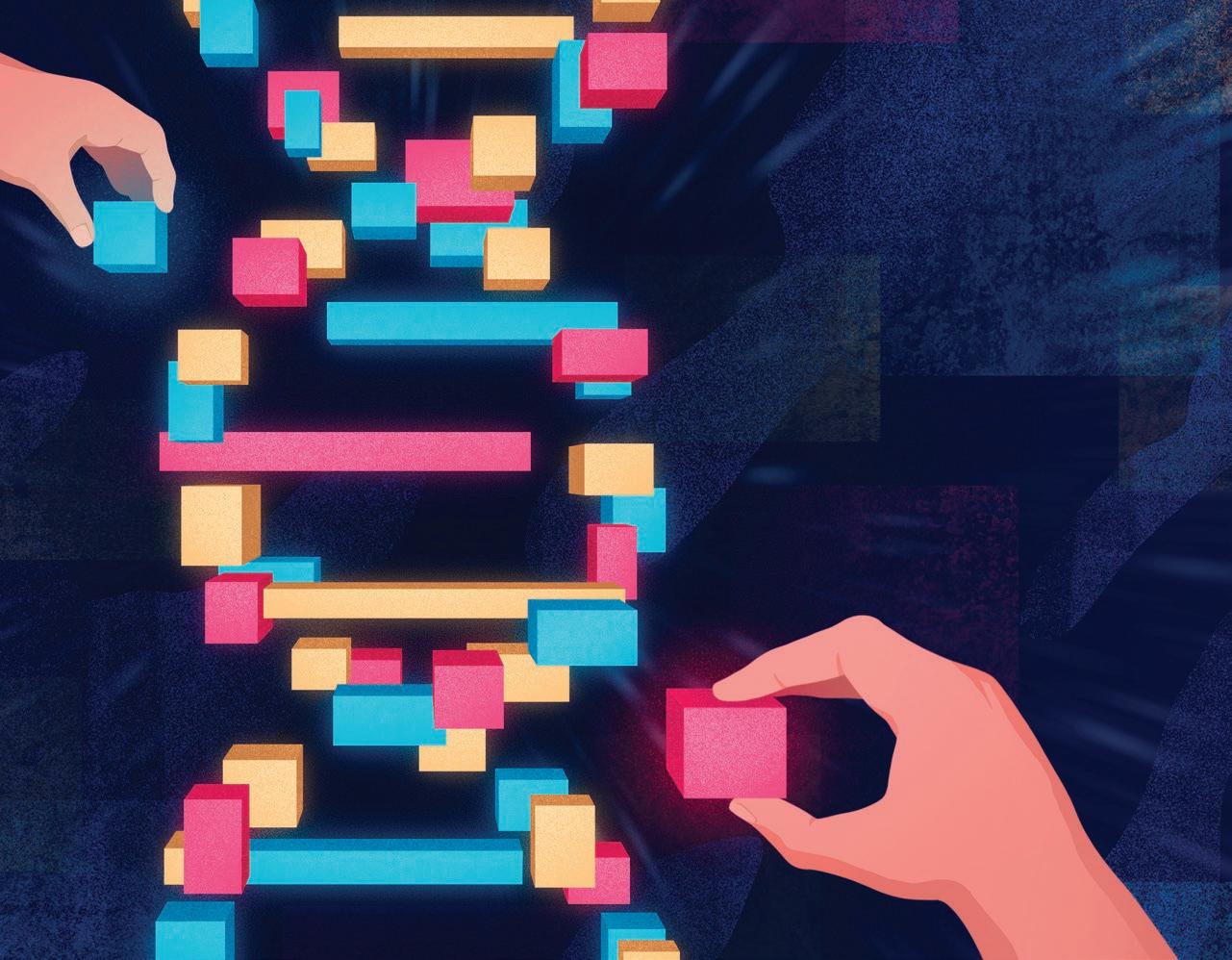

In Salk’s Year of Alzheimer’s Disease Research, we’re sitting down with the experts behind bold new approaches to studying the condition. Hear from Jeff Jones, a staff scientist from South Florida whose experiments are revealing the role of DNA damage in aging and Alzheimer’s—and how brain organoids could help us find a way to fix it. Subscribe and stay tuned to hear what makes Alzheimer’s research at Salk so special.

Donald Cohn, San Diego real estate developer and community builder, died May 2, 2025, at the age of 93. A generous supporter of the arts, education, and science, he served on the Salk Institute’s Board of Trustees from 2014 to 2022.


“All of us at the Salk Institute were deeply saddened to learn of Don’s passing,” says Salk President Gerald Joyce. “Don was a valued member of our Board of Trustees and a true friend and champion of our mission. His thoughtful guidance, business acumen, and unwavering belief in the power of scientific discovery left a lasting impact on our Institute. Together with his wife, Karen, Don’s generous support of our annual Symphony at Salk gala helped bring our community together in celebration of science and the arts. We are profoundly grateful for his many contributions and will remember him with great respect and admiration.”
Valeiras joined the Salk Institute’s Board of Trustees as of April 2025. His scientific background in chemical engineering informed his subsequent MBA studies and 40-year career in finance. Valeiras’ new appointment at Salk further roots him in La Jolla, where he has lived for more than 20 years and currently serves as CEO of Frontier Global Partners.



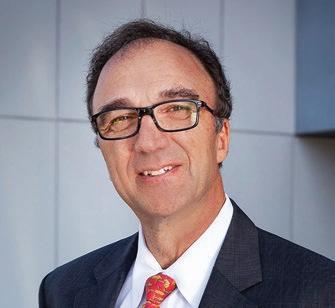
David Julius, Stephen Quake, and Brenda Schulman have been named Salk Nonresident Fellows. Julius is a professor, chair of the Department of Physiology, and holder of the Morris Herzstein Chair in Molecular Biology at UC San Francisco. He shared the 2021 Nobel Prize in Physiology or Medicine for discoveries of temperature and touch receptors. Quake is the Lee Otterson professor of bioengineering at Stanford University, head of science at the Chan Zuckerberg Initiative, and founding co-president of the Chan Zuckerberg Biohub. Brenda Schulman is a professor and the director of Molecular Machines and Signaling at the Max Planck Institute of Biochemistry.
Sejnowski, a pioneer in computational neuroscience and artificial intelligence, was elected to the Royal Society as a Foreign Member and elected to the American Philosophical Society (APS). These prestigious elections recognize his outstanding leadership and extraordinary achievement in computational neuroscience. The Royal Society is an independent scientific academy in the United Kingdom dedicated to promoting excellence in science for the benefit of humanity. Founded in 1660, the Royal Society is the world’s oldest scientific academy in continuous existence. Founded in 1743 by Benjamin Franklin, APS is the oldest learned society in the United States. The society aims to gather creative thinkers in the sciences and beyond to promote the free exchange of ideas and critical thought for the public’s best interest.
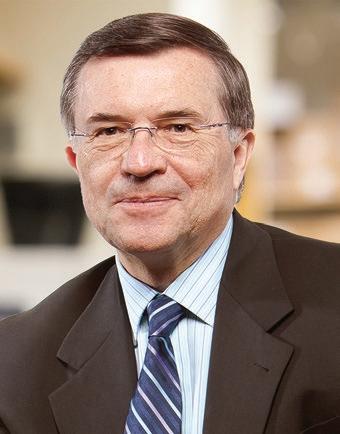


Lemke is one of 120 new members and 30 foreign associates to be elected to the US National Academy of Sciences, recognizing his distinguished and continuing achievements in original research. This election is considered one of the highest honors accorded to a scientist in the United States. Lemke, a neuroscientist, is known for discovering the TAM family of cell receptors and their role in brain inflammation. His recognition brings the number of Salk faculty elected to the National Academy of Sciences to 14.



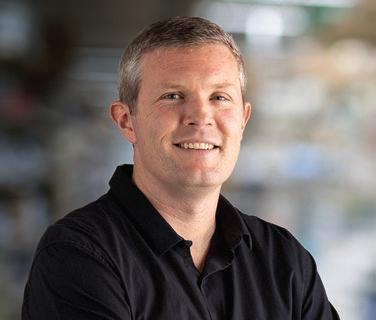
Associate Professors Nicola Allen and Diana Hargreaves were promoted to full professors, and Assistant Professor Jesse Dixon was promoted to associate professor. The promotions were based on Salk faculty and Nonresident Fellow recommendations and approved by Salk’s president and Board of Trustees in April 2025.

“Nicola has made critical contributions to Salk’s programs in neuroimmunology and Alzheimer’s disease, and both Diana and Jesse have made important advances in cancer research. We are excited to see how their leadership and innovation will continue to shape the Institute’s success.”
PRESIDENT GERALD JOYCE
Panda was named a semifinalist in the XPRIZE Healthspan competition. This seven-year, $101 million competition aims to revolutionize the way we approach human aging. He will receive $250,000 to test the feasibility of comprehensive personalized circadian rhythm optimization plans in a small group of older adults. The goal is to extend healthspans—the period of our lives during which we remain in good health.


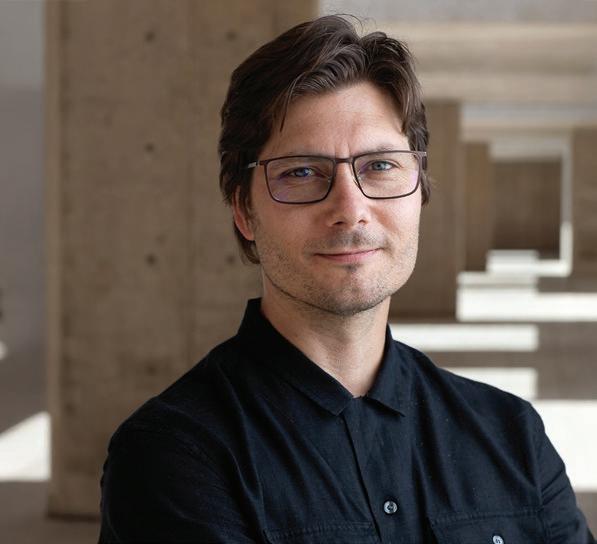


Awarded to two researchers annually—one in biological sciences and the other in physical sciences—since 1975, the Burton Medal recognizes scientists who have made distinguished scientific contributions to the field of microscopy and microanalysis. Lyumkis earned the award in the area of biological sciences, owed to his “impactful contributions furthering our mechanistic understanding of infectious diseases through the lens of protein biophysics and structural biology.”


At the Salk Institute, bold science meets boundless possibility. Now, through the Discovery Society, you can become part of an exclusive community that champions pioneering research and helps shape the future of human health, agriculture, and technology. Your support empowers breakthroughs across cancer, Alzheimer’s, healthy aging, plant science, and more.
As a Discovery Society member, you’ll enjoy benefits such as exclusive invitations to events, early access to major discoveries, and personalized VIP tours of Salk’s iconic architecture and labs. It’s a front-row seat to the future of science and a lasting connection to a global community of changemakers.
Gerald Joyce President
Michelle Chamberlain Vice President, External Relations
Heather Buschman Senior Director, Communications
Amy Cao Science Illustrator
Isabella Davis Science Writer
Alex Endsley Graphic Designer
Stephanie Harada Manager, Digital Communications
Kathleen Hart Communications Manager
Aaron Howard Manager, AV and Video Communications
Mike Jeffs Multimedia Producer
Victoria Johnson Media Relations Manager
Chris Keeney Photo Journalist
Nicole Mlynaryk Manager, Scientific Communications
Kent Schnoeker Senior AV Technician
Elizabeth Shepkin Marketing Communications Manager
Kara Sjoblom-Bay Communications Administrator
Oliver Yambao Senior Graphic Designer

Visit the Salk Institute at www.salk.edu.
Inside Salk is published by the Salk Institute for Biological Studies. Please send comments to communications@ salk.edu or contact the Communications Department at (858) 453-4100 x1371. Inside Salk is printed on recycled paper.

Salk Institute for Biological Studies
10010 N Torrey Pines Rd
La Jolla, California 92037-1002
Telephone: (858) 453-4100 www.salk.edu



For detailed information on opportunities, please email giving@salk.edu, call (858) 453-4100 x2068, or visit www.salk.edu/donate.

